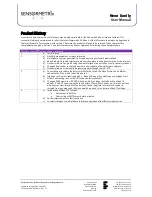
Neon Family
User Manual
Sensormetrix is a division of Sequoia Technology Group Ltd
Registered in England No. 4004881
VAT Registration No. GB614 5653 45
Sensormetrix
sales
+44 (0) 845 451 2021
Basingstoke Road
fax
+44 (0) 118 976 9020
Spencers Wood
Reading
web
www.sensormetrix.co.uk
Berkshire RG7 1PW
Page 37 of 39
The data transfer bandwidth used by viewing the home page is 4114 bytes/second uploaded by the Neon and 647
bytes/second downloaded by the Neon. When the unit is connected via the Sequoia RUT500, this will allow on line data
costs to be predicted.
Important:
Data will flow for as long as the web page is open in a browser, even if the browser is minimised. The only way to
stop the data flow is to close the browser. Each browser window connected (be they on the same PC or different PCs) will
use the shown data rate.
Connection via WiFi
The Neon may be connected to a Wireless access point to WiFi enable the product. Not all wireless access points are able to
work in the correct way to allow this. Please contact Sensormetrix for details of solutions that will work with the Neon.
Fixing the IP address
Rather than fix the IP address at the Neon, the better way to fix the IP address is to use the DHCP server. Most DHCP servers
will allow an IP address to be fixed or bound to a specific MAC address. The advantage of this is that the Neon will always
have a fixed address, but it is actually picking up all the networking parameters from the server. This means that if any of
the networks characteristics are altered over time (new gateway, different DNS server, etc) these changes will automatically
ripple down to the Neon rather than have to be changed on the Neon. Additionally, the fixed IP binding should be clearly
visible to anyone doing the network administration while if it was fixed at the Neon this would not be immediately
apparent.
Hysteresis explained
Hysteresis is the dependence of a state on not only its current condition but also its past condition.
Hysteresis is best explained by an example. Suppose that a product has a hysteresis of 1°C and has the temperature alarm
set at 40°C. As the measured temperature slowly rises from below 40°C to greater than 40°C, an alarm state will exist when
the temperature exceeds 40°C and will continue to persist at any temperature over 40°C. This would be expected
behaviour.
However, with 1°C of hysteresis, when the temperature drops the alarm state will persist until the temperature has dropped
to 1°C below 40°C (39°C). This means that when the temperature is falling between 40°C and 39°C, this will still be an
alarm state. This is the dependence of the current state with the past. Applying hysteresis prevents a possible flood of
email alerts if a measured value dithers around an alarm threshold.
Neon 100 SNTP settings
The Neon 100 was designed specifically with the email settings pre-configured to make it easy to use. In some applications
this is not always desirable. While it is not supported by Sensormetrix, advanced users may redirect emails to their own
server by altering their local networks DNS to redirect emails to their own server. If the alternative email server does not
require authentication, this can be achieved knowing the settings that are pre-set in the Neon 100. If authentication is also
required a password is required. This is available on application to Sensormetrix and will only be done so if a non-
disclosure agreement is signed. Note that SSL/TLS is not supported.
SMTP server: "mail.servergateway.co.uk"
SMTP port: 25
SMTP account: [email protected]
SMTP password: By request only
SMTP address: [email protected]
If entering of the users own a SMTP setting is required, the Neon 110 should be used rather than the Neon 100.


































